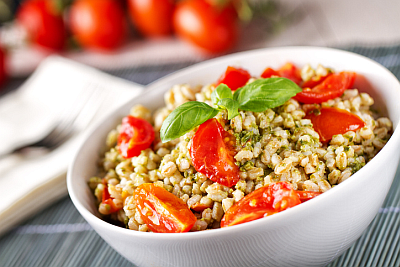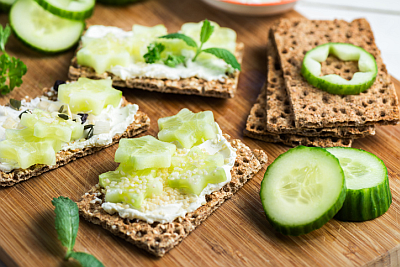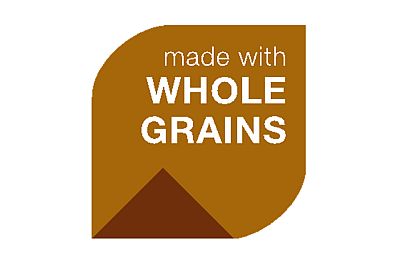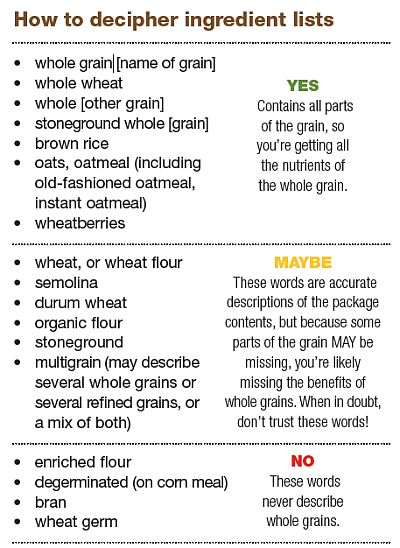You may hear people talking about ditching carbs these days to stay healthier and shed pounds. And since wheat and other grains are one of the top sources of carbs in our diets from foods like bread, pizza and pasta, there’s a lot of ‘grain-free’ fad diet talk out there. But if you’re treating all carbs and all grains as equal, you’re not getting the whole story—the whole grain story, that is.
 Aramark registered dietitian Mary Cummings helps clear things up. She explains why most of us should actually be getting more of a certain type of grain in our diet. But to start, she explains why there are some types of grains where less is better.
Aramark registered dietitian Mary Cummings helps clear things up. She explains why most of us should actually be getting more of a certain type of grain in our diet. But to start, she explains why there are some types of grains where less is better.
“Reducing the amount of refined grains you eat from foods like regular white bread, plain rolls and other baked goods is something most of us should do for better health,” says Mary. “But there is a world of difference between refined and whole grains, and there are actually big benefits to including whole grains in your diet. In fact, the USDA’s Dietary Guidelines for Americans recommends eating grains daily, and making at least half of them whole grains.”
Turns out that whole grains contain filling fiber, plant-based protein, and other vitamins and minerals your body needs to stay healthy, reduce the risk of several chronic diseases, and help you feel better and have more energy.
The Scoop on Whole Grains
 All grains start off whole. However, when they’re milled into their refined form the nutritious bran (the outer layer with its fiber, B-vitamins and minerals) and the germ (the nutrient-packed heart or core of the grain) are stripped away, leaving only the starchy middle layer. Once these parts are taken away, the refined grain is missing almost all of the original fiber, a large portion of the naturally occurring beneficial nutrients, and a significant amount of the protein. While many manufacturers try to compensate by adding back some lost nutrients through vitamin enrichment, unfortunately, with so much of the good stuff removed, refined grains are less healthy for you.
All grains start off whole. However, when they’re milled into their refined form the nutritious bran (the outer layer with its fiber, B-vitamins and minerals) and the germ (the nutrient-packed heart or core of the grain) are stripped away, leaving only the starchy middle layer. Once these parts are taken away, the refined grain is missing almost all of the original fiber, a large portion of the naturally occurring beneficial nutrients, and a significant amount of the protein. While many manufacturers try to compensate by adding back some lost nutrients through vitamin enrichment, unfortunately, with so much of the good stuff removed, refined grains are less healthy for you.
Whole grains on the other hand include every nutritious part of the grain. And this is true for all grains, not just wheat. Everything from wheat, corn, rice, oats, barley, quinoa, farro, sorghum, spelt, and rye start as whole grains and that’s the best way to eat them.
What Makes Whole Grains Great?
“By eating the whole grain, you’re getting many nutrients, including several B vitamins, like thiamin, riboflavin, niacin, and folate, and minerals such as iron, magnesium, and selenium,” Mary notes. “Together, these nutrients give you energy, and support your body’s immune and digestive systems.”
 Additionally, the fiber from whole grains plays a really important role in your health. To start, fiber in the diet can help improve blood cholesterol levels and lower the risk of heart disease, stroke, obesity, and Type 2 diabetes. “This same fiber can help you lose or manage your weight by keeping you fuller longer,” she explains.
Additionally, the fiber from whole grains plays a really important role in your health. To start, fiber in the diet can help improve blood cholesterol levels and lower the risk of heart disease, stroke, obesity, and Type 2 diabetes. “This same fiber can help you lose or manage your weight by keeping you fuller longer,” she explains.
The Whole Grain Difference
Why does eating a whole grain make such a big difference in the way you feel? When you eat whole grains, they are digested more slowly. The fiber in the whole grain literally slows down the digestion process. This, says Mary, is a good thing! “It means that you feel satisfied longer, in part because it helps avoid the kind of blood sugar spikes you can get when eating refined grains, which are digested more quickly.”
Eating refined grains can actually make you feel hungrier not long after you eat them. The refined grains, without the fiber, are digested quickly, raising your blood sugar faster than whole grains. But, as they say, “what goes up must come down,” and, after the blood sugar rise comes the fall—and when your blood sugar starts falling, your body naturally tells you to eat more (some call it “rebound hunger”)!
The example: White rice, stripped of its nutritious outer layer, gets digested very quickly and will cause hunger shortly after. Whole grain brown rice on the other hand keeps its outer layer intact, so it digests more slowly and is more filling and satisfying.
So, for so many reasons, replacing some refined grains with whole and minimally processed grains in your diet is a healthy step in the right direction.
How to Put More on Your Plate
 The Dietary Guidelines for Americans recommends that one quarter of your plate be made of grains, and that at least half of all the grains you eat should be whole. That translates to about three to four ounces of whole grains a day. It’s actually easy to do, but it can be tricky to pick out foods that are truly whole grain.
The Dietary Guidelines for Americans recommends that one quarter of your plate be made of grains, and that at least half of all the grains you eat should be whole. That translates to about three to four ounces of whole grains a day. It’s actually easy to do, but it can be tricky to pick out foods that are truly whole grain.
If you’re dining with us at an Aramark location, just look for the leaf-shaped “made with whole grain” sign to find menu selections that have whole grains as a leading ingredient.
“If you’re shopping in the grocery store, look for the whole grain stamp from the Whole Grains Council, which tells you that a food has at least half a serving of whole grains inside,” Mary advises.
Need more help? Here’s advice to spot
whole grains in ingredient lists.
Whole Grain Creativity–So Many Ways
To get to the goal of half of your grains being whole, start by swapping in whole grain products to replace some refined grain products you normally eat. You can make these changes gradually—pick up some 100% whole-wheat bread, bagels, pasta, or tortillas instead of the regular kinds. Plain oatmeal makes a yummy breakfast when you add your own mix-ins.
As for snack time, “Many people are delighted to discover that popcorn is a whole grain,” Mary shares. “It makes a fun, filling snack as long as you don’t add much salt or butter.”
Leftover cooked brown rice, bulgur, or barley keep well in the freezer, so you can make big batches to reheat and serve later as a side dish. You can also try whole grains in mixed dishes—think barley in vegetable soups and casseroles, or bulgur wheat as a base for stir-fry.
It’s a great way to up the health factor of some of your family’s favorite dishes. They may not even notice, but their bodies will thank you!
Note: Since everyone’s health history and nutritional needs are so different, please make sure that you talk with your doctor and a registered dietitian to get advice about the diet and exercise plan that‘s right for you.

